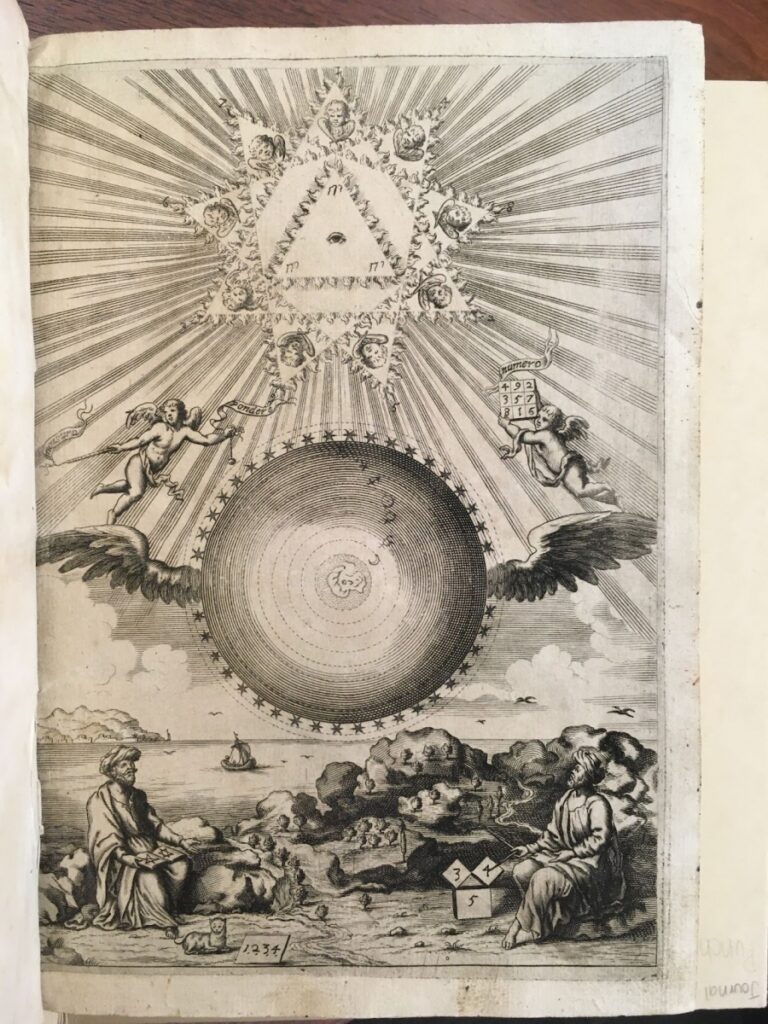Ouroboros Sphere or Winged Globe

The frontispiece is from Athanasius Kircher’s “Arithmologia sive De abditis Numerorum mysteriis,” published in 1665.
In medieval manuscripts, it was common for frontispieces to feature elaborate illustrations or the author’s portrait. In the context of esoteric or alchemical texts, frontispieces frequently incorporated intricate symbols and diagrams designed to convey deeper philosophical or mystical meanings. The phrase “Arithmologia sive De abditis Numerorum mysteriis” is in Latin. In English, it translates to “Arithmology or On the Hidden Mysteries of Numbers.” This title reflects the book’s focus on the mystical and numerical properties of numbers, exploring their deeper, often esoteric significance.
Kircher, a Jesuit priest and polymath, looked into the mystical and numerical properties of numbers, merging mathematical rigor with religious mysticism. The engraving features a hexagram, the Eye of Providence within a triangle, cherubs, and philosopher-like figures. The hexagram, also known as the Star of David or the Seal of Solomon, symbolizes the union of opposites and holds significance in various traditions. The Eye within the triangle represents divine omniscience. These symbols were prevalent in esoteric and alchemical texts of the Renaissance and early modern periods, aiming to convey deep philosophical and mystical insights.
The sphere with wings in the image is known as the “Ouroboros Sphere” or “Winged Globe.” This symbol combines the concept of eternity and cyclical nature, often represented by the Ouroboros, a serpent eating its own tail, with the sphere, representing the universe or perfection. The wings typically signify divine or celestial movement, suggesting the dynamic nature of the cosmos and its continuous transformation. This iconography is commonly found in alchemical and esoteric traditions, symbolizing the unity of the heavens and the earth.
The hexagram, or six-pointed star, composed of two overlapping triangles, signifies the union of opposites, such as male and female or spiritual and physical realms. Historically, this symbol has been used across various cultures, including ancient Jewish, Christian, and Islamic art and texts. The Eye of Providence within a triangle is often associated with the divine’s omniscience and watchfulness, particularly prevalent in Christian iconography.
This frontispiece fits within the tradition of illustrated esoteric texts from the Renaissance period. Artists like Heinrich Khunrath, known for his “Amphitheatrum Sapientiae Aeternae,” and John Dee, author of the “Monas Hieroglyphica,” produced similar illustrations rich with symbolic content, integrating alchemical and mystical themes. These illustrations were designed not just for decorative purposes but also to serve as visual aids for meditative and scholarly activities.
The elements such as a 3×3 magic square and a scholar demonstrating the Pythagorean theorem in the frontispiece emphasize the blend of mathematical and mystical themes in Kircher’s work. This illustration exemplifies the tradition of combining artistic representation with profound metaphysical concepts, serving both as a decorative piece and a tool for esoteric study.

